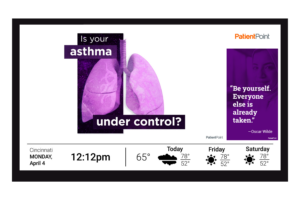The waiting room is the perfect place to educate patients. This is a time when patients are actively thinking about their health and preparing what to say to their provider. Many practices show the news or daytime television. While a TV may keep patients entertained, it doesn’t help them feel more prepared and confident to speak to their doctor.
That’s why your practice should replace cable with a patient education waiting room program instead.
There’s no need to choose between print or digital
If you already have patient education in your waiting room that includes handouts, posters and/or flyers, that’s great. In fact, older patients who come into your office may prefer paper over electronic information. And with handouts, in particular, they can take relevant information with them into the exam room to reference during the appointment and bring it home to share with their family members.
For these reasons, if you’ve found a convenient and budget-friendly way to provide paper education, we see no reason to stop. However, you will find that there are a lot of additional benefits when you make the switch to digital education channels.
Why a waiting room education TV?

Patient engagement technology, specifically a waiting room TV, is a great way to reach your diverse patient population. These programs are designed to show a mix of specialty-specific education, healthy living advice, interactive quizzes and inspirational videos to grab a patient’s attention. And you can customize the device to add the information you most want patients to receive—screening reminders, office hour changes, seasonal best practices, patient portal reminders, etc.
When we compared practices with our waiting room device to practices that didn’t have our device, we found that our provider partners experienced a 3% increase in billable claims per health service.* Some locations experienced even greater results—a 28% increase in flu vaccinations and a 45% increase in mammograms, for example.* These results prove the effectiveness of waiting room devices at improving screenings and ultimately health outcomes.
The reason this technology works is because it uses simplified, actionable patient education that individuals with different health literacy levels can understand. Patients leave the waiting room with more motivation to act—whether that be to request a screening, log into their patient portal or simply speak with their doctor about symptoms they wouldn’t have thought to bring up before.
Karla Smith, the Director of Human Resources at Mid Dakota Clinic, told us, “One of our patients said she had been watching PatientPoint and saw some information explaining symptoms of diabetes. The patient stated that she was experiencing some of those symptoms and asked if she should make an appointment and be checked for diabetes. Heck yeah! This is what we want to accomplish.”
If you’re interested in adding a waiting room device to your practice or want more information about how this can help you meet your practice goals, request a demo of our no-cost solution.

